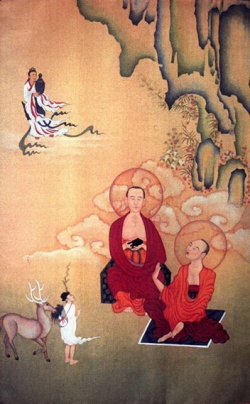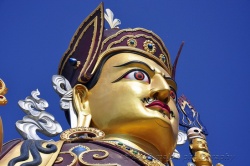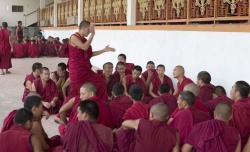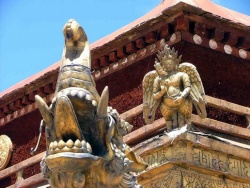Tsok
Tsok (Tib. ཚོགས་, Wyl. tshogs, from Skt. gaṇacakra, Tib. ཚོགས་ཀྱི་འཁོར་ལོ་) — an important Vajrayana practice of offering and purification practised especially on the 10th and 25th days of the Tibetan month.
The Meaning of Tsok
All practices on the path to buddhahood are methods for gathering the accumulations of merit and wisdom and for purifying our obscurations. These two processes of accumulation and purification go hand in hand; as we accumulate more merit and wisdom, our obscurations automatically diminish.
As we mentioned earlier, the Secret Mantra Vajrayana features countless skilful and powerful methods which, if they are practiced in the proper way, can make the process of accumulation and purification incredibly swift and direct. One such method is the practice of tsok, which is primarily a practice of offering. It is not just a practice of offering however; it is also a powerful method for purifying our samaya. Sometimes it is said that the best method for purifying samaya is the fire offering, and tsok practice is the ‘inner fire offering.’ Tsok is a very rich practice with many layers of meaning, and it can be practised on various levels. It is said that as ordinary beings we are only able to imitate the real tsok practice, which is performed by the dakas and dakinis.
The Sanskrit word for tsok practice is ganachakra, which in Tibetan is ཚོགས་ཀྱི་འཁོར་ལོ་ tsok kyi khorlo. The word {{BigTibetan|ཚོགས, tsok means ‘an accumulation’ or ‘a gathering, an assembly or group’, and the word འཁོར་ལོ་, khorlo literally means ‘wheel.’ So the literal translation is something like ‘wheel of accumulation.’ According to the great master Jamgön Kongtrul, this term relates to the inner level of tsok practice, and the generation of vast ‘gatherings’ of bliss that are like ‘wheels’ which cut through the web of our deluded thoughts and tainted emotions. Tsok happens twice a month every month. It is a special day where the dakinis of the 24 holy places gather together to bless the tantric practitioners body, nerves, chi, chakras, speech and mind. On Tsok day we can perform a special tsok to… our yidam or a general tsok for all the Three Jewels (Lama Chopa). Tsok gathers tremendous amounts of merits to support our tantric meditations in order to get results.
Tsok tradition was started (from Buddha) in Ancient Indian Buddhism by the great Buddhist Mahasiddhas such as Tilopa and Naropa etc..and brought to Tibet as a means for tantrikas who have little means to gather great merits in order to gain attainements. Atisha and Guru Rinpoche shared Tsok practice with the Tibetans 1,000 years ago. Once you recieved higher tantra initiation you must perform tsok twice a month for life. Today is tsok day. And the Tantrikas gather at Kechara to perform Lama Chopa like they do twice every month.
The Four Gatherings
The teachings explain that ‘tsok’ refers to four different types of gathering, those of:
- 1. practitioners,
- 2. offering substances,
- 3. deities, and
- 4. merit and wisdom.
1. The Gathering of Practitioners
In the teachings this is known as the ‘gathering of fortunate individuals’ because only beings with the greatest good fortune can meet and practise the Vajrayana path. The male and female tantric practitioners gather together to celebrate the tsok feast on the tenth day of the waxing moon and the tenth day of the waning moon, as well as on special anniversaries in the Buddhist calendar.
Tsok can also be offered in gratitude whenever we gain signs of accomplishment in our practice, or for purification whenever signs of an impairment or breakage of samaya occur.
An important part of the practice is pure perception, so everyone is viewed according to his or her enlightened nature—all the male practitioners as dakas who embody skilful means, and all the female practitioners as dakinis, who are the embodiments of wisdom.
It is said in the tantras that the male practitioners should sit on the right and the females on the left, facing each other, with the vajra master in the centre and facing the assembly. Practitioners should wear their best clothes to provide an auspicious connection for the accumulation of merit.
Some masters say the practitioners should sit in order of seniority, according to when they first received empowerment into the Vajrayana, or according to their levels of experience and realization and their qualities as a practitioner.
It is best to have an equal number of male and female practitioners, as this symbolizes the balancing of skilful means and wisdom.
We should consider the place where we gather not as an ordinary room or building, but as the sacred place where Guru Rinpoche himself practises the tsok feast, in the company of infinite dakas and dakinis.
2. The Gathering of Offering Substances
This is traditionally referred to as the gathering of ‘delightful substances.’
It refers to the food and drink that will be offered by the practitioners during the practice. It is said that the edible substances represent skilful means and the liquids represent wisdom. It is important that the offering includes many different substances, especially, it says in the tantras, meat and alcohol.
The teachings also stress that we should be generous in our offerings, and not offer just a little amount with a miserly attitude. We should try to avoid polluting the offerings with limited dualistic concepts, by thinking something is too good or too expensive to offer, or even that something is too dirty or impure, or only offering things we like ourselves and leaving out all the things we don’t like.
It is important that we consider the substances as offerings, and not as ordinary food and drink. To anticipate eating or drinking the tsok is what it says in the practice of Narak Kong Shak is ‘tsok wolf’ behaviour. Kyabjé Dilgo Khyentse Rinpoche would say that this also includes bringing cups and plates together with the offerings, which shows one is already thinking about consuming them.
3. The Gathering of Deities
This is traditionally called ‘the gathering of deities who are the source of accomplishments.’ The word ‘gathering’ signifies that we are not just offering to a single deity, but to an entire mandala, or even several mandalas of deities, each consisting of the principal deity together with the retinue. It is important that we have some image—a statue, a thangka painting or a photograph of the mandala or of our own root master—whenever we offer tsok, as a support for the practice.
4. The Gathering of Merit and Wisdom
The final gathering is the result of the first three. The practice of tsok is a very powerful method for accumulating merit and wisdom.
The definitions of merit vary, but in simple terms we can think of the practices for accumulating merit as being the more conceptual aspects of the practice—visualization, generating devotion and compassion, offering, confessing and so on—and the practices for accumulating wisdom are the more non-conceptual aspects, such as the dissolution of the visualization.
On a deeper level, we accumulate merit by not grasping at anything during the practice, and we accumulate wisdom by remaining with non-conceptual reference.
The Benefits of Tsok Practice
The main benefit of tsok practice mentioned in the tantras is the accumulation of merit with conceptual focus as well as the accumulation of wisdom beyond focus. There could be no greater benefit than this.
In the termas, we also find mention of unimaginable benefits. For example, it is said that Guru Rinpoche himself will come and bless the tsok practitioners, or that the place where tsok is performed will become exactly the same as the Zangdokpalri heaven of Guru Rinpoche. And Yeshé Tsogyal said that to practice tsok just once closes the door to lower rebirths.[1] It is also said that disease, famine and warfare will be pacified, and all the practitioners’ wishes will be fulfilled without the slightest obstacle.
Notes & References
- ↑ See Gyalwa Changchub and Namkhai Nyingpo, Lady of the Lotus-Born: The Life and Enlightenment of Yeshe Tsogyal, translated by Padmakara Translation Group, Shambhala 1999, page 204.
Teachings Given to Rigpa Sangha
Many teachings on tsok have been given to the Rigpa Sangha including:
- Khenpo Palden Sherab, Rigpa London, 14 May 1985
- Nyoshul Khen Rinpoche, Tenby, Wales, 26 March 1986
- Kyabjé Penor Rinpoche, London, 18 November 1988
- Orgyen Tobgyal Rinpoche, Lerab Ling, 13 July 2002
- Sogyal Rinpoche, Lerab Ling, 9 August 2012
Further Reading
- A Guide to Vajrayana Practice for the Rigpa Sangha (Lodeve: The Tertön Sogyal Trust, 2006), Section 6. 'Tsok' (based on teachings by Orgyen Tobgyal Rinpoche, with additions from Kyabjé Trulshik Rinpoche and Khenchen Pema Tsewang).
- The Meaning of Tsok and How to Practice Tsok Simply (Lodeve: The Tertön Sogyal Trust, 2007)
- Gonpo Tseten Rinpoche, The Udumbara Bouquet or The Life of Guru Rinpoche and the Meaning of the Tsog Offering (1981)
see also; Ganachakra




